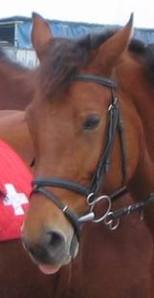When is a Gag not a Gag at all?
Posted by Anita Marchesani on May 02, 2014
The Dutch Gag is a very common bit for jumpers and eventers. The Dutch is also known by the names Pessoa Gag, Three Ring-, Four Ring-, (and erroneously, a Two Ring-) Gag with variations on the shape such as the “Wonder Gag”. When describing your dutch gag, or if you are shopping for one, always describe it by counting all the rings, including the “snaffle” ring- hence the Four ring and Three Ring Dutch Gag. But really, these bit’s aren’t gags at all. I argue that they are closer to the curb and leverage family of bits, like the pelham and weymouth than a true gag action. Here’s why…
A Gag bit accentuates the lifting action of the direct action snaffle bit, by increasing the pressure applied to the corners of the lips, asking for the head to come up. A Gag bit (and in this instance I mean those in the running gag family, such as the Balding, Cheltenham and Nelson Gags) has cheek straps running through holes in the rings that the reins are attached directly to. Rein pressure causes the bit to slide on these cheeks up the mouth, pulling the lips. It is this sliding up and pull that the horse responds to by lifting his head. A Gag bit can be very useful for a horse that tends to travel quite long and low, with his nose on the ground and when used sympathetically, can help lift his head and focus on the fence as they set up. It can however, be a very powerful method of control, and there is a danger of the cheeks being trapped between teeth and bit so for this reason, it is not a great bit for those horses with very fleshy faces or for riders that do not have releasing hands and an independent seat. http://www.bitbankaustralia.com.au/gag-bits/
A Cheltenham Gag with two reins attached.
The Dutch Gag was designed to combine this sliding and pulling on the lips with the leverage action of a shank. A bit with leverage pressure- a shank extension below the mouthpiece- is asking for head lowering, “outline” and nose retraction. So, the Dutch Gag is trying to ask for lifting and lowering at the same time. Can you see the problem with this?
In reality, a greater amount of pressure is applied to the tongue and lower jaw through the lower rings (the “shanks” of this bit), than is applied to the lips, so the majority of horses will respond more the leverage pressure, rather than the gag action. The Dutch Gag is therefore really not a gag at all, it is a leverage bit, and as such asks for head lowering. It is not particularly elegant solution, as most riders use this bit with only one rein on the bottom rings, which leads to very fuzzy direction aids. (Remember, your snaffle gives you the best indication for turning aids, as it is a direct action bit, this is one reason why a double bridle combines a bridoon and weymouth combination).
A Four Ring Dutch gag
Another factor that riders are often not aware of, is the shear amount of force that is applied, through leverage, on the Dutch Gags, particularly the Four Ring gag. Look at the length of extension below the mouthpiece- it is often longer than the 10cm legal length for a curb/ weymouth bit. This leverage force significantly increases the amount of pressure applied to your horse’s mouth from what you are applying from your hands. So, to explain it a little, if you feel like you are holding 1 kg of weight in your hand, your horse may be holding 8kg in his mouth.
Don’t get me wrong, I don’t hate the Dutch Gag. I just think it is over used and often used for the wrong reasons. It is often the very first bit riders try when the feel a snaffle not enough. However, it is not the right choice for a horse that already runs with his head down or low, already evades contact by sitting behind the bit or one that dislikes strong pressure on the lower jaw. If you have an exuberant jumper, who comes into a fence with his head up high in the sky, it would certainly be a bit worth considering. http://www.bitbankaustralia.com.au/dutch-gags/
Tip: Both the Gag and the Dutch gag can (and ideally in my opinion, should) be ridden with two reins. One on the snaffle ring and one on the lower ring in the case of the Dutch, or the gag rein in the case of the true gag. This means you have the directional control of the snaffle that you lack with the Dutch gag normally, and can use the running gag as a normal snaffle, until you need to pick up the gag rein in approach to a fence. This should only be attempted if you are completely confident with that much knitting, and to help keep everything in order, use a bit of electrical tape to tape the buckles of the two reins together so you can always quickly pick them up in the case of a whoopsie.
So in my mind, the Dutch Gag isn’t a gag at all. It really is closer to a pelham or weymouth in the way it works and interacts with your horse. I hope that this explains a little why so many horses in Dutch gags end up with their chin on their chests and their riders with nothing in front coming into a fence!
Happy riding,
Anita
(originally published 22/1/2011)
 NZD
NZD  Australian Dollar
Australian Dollar
 US Dollar
US Dollar


